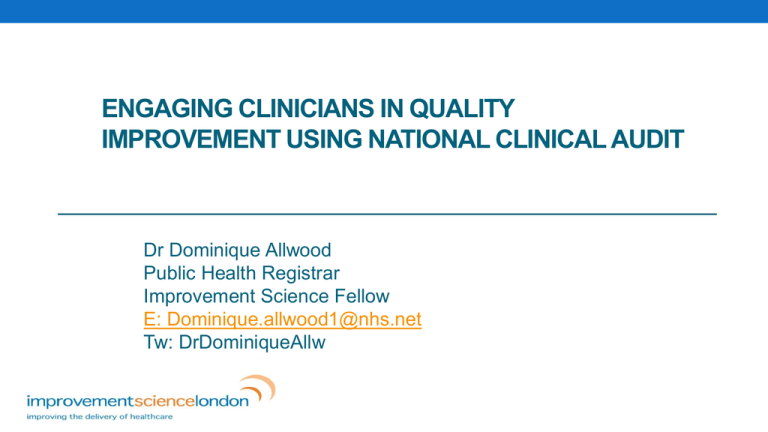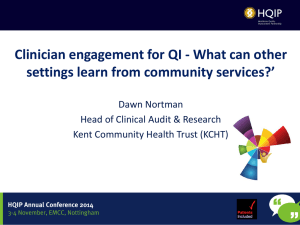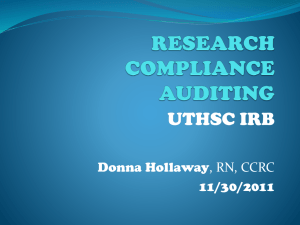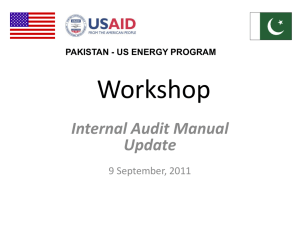Dr.D.Allwood - Facilitators and barriers to local improvement
advertisement

ENGAGING CLINICIANS IN QUALITY IMPROVEMENT USING NATIONAL CLINICAL AUDIT Dr Dominique Allwood Public Health Registrar Improvement Science Fellow E: Dominique.allwood1@nhs.net Tw: DrDominiqueAllw The Project Background • Despite being well organised and reasonably well funded, large scale audits are undervalued as a potential resource to support improvement • The Francis Inquiry report highlighted the need for trusts to focus more on quality • HQIP commissioned ISL to undertake a project to understand more Aim • Project aimed to better understand the barriers and facilitators in using NCA to support local quality improvement Method • Thirty participants contributed their views through interviews or focus groups conducted in 2013 Participants Themes 1. Technical and Practical Issues 2. Communication 3. National and local alignment to quality improvement • • • • • • Analysis Interpretation Presentation Recourses Knowledge Skills • Content and purpose • Engagement • Motivations and incentives • Structures, systems, staffing and culture Key Findings (1) • There is a need to clarify the content and purpose of some national clinical audits so that local healthcare providers understand the relevance and importance of audit and can use this data to make improvements to services • Support with how to analyse and interpret data and present findings to others in user-friendly ways would help people to engage better with audit findings • Incentives to drive improvement could act as both barriers and facilitators. Recognition of good practice was seen as a powerful motivator while financial incentives received a mixed response Key Findings (2) • The right resources, knowledge and skills are needed to encourage engagement with clinical audit. Face to face events were seen as one of the best tools for building understanding and sharing best practice • Organisational structures, governance, staffing and culture all had a strong influence on the take up of clinical audit and on whether data was used to encourage improvement • More could be done to engage clinical leads with HQIP. Participants would like to see greater involvement of clinicians and input from patients in the design and reporting of clinical audits 1. Technical and practical issues Analysis Presentation Knowledge and skills Methodology Timeliness Education, training and ability Access to skills Time Interactivity/ IT systems Events HQIP Conference Interpretation of data Prioritisation Uncertainty Customisation Presentational skills Interpretation Change Workshops Peer groups/ networks Engagement Data vs. information Guidance and tools Duplication Interpretative and analytical Comparisons – case mix, adjustment Participate in learning Data collection Sharing best practice Professional bodies and audit suppliers 2. Communication Content and Purpose Communication and reporting Engagement and Dialogue Data collection vs. audit Between clinical audit leads and clinical teams Between HQIP and local audit teams Between clinical audit leads and local audit team Between HQIP and clinical leads Between suppliers and trusts Between HQIP and suppliers External reporting Interpretation Audit vs. improvement & Improvement vs. judgement Evidence-based standards vs. aspirational targets Relevance Mechanism for improvement 3. National and local alignment to quality improvement Incentives and motivations Awareness Recognition, competition, clinical excellence awards Regulatory – appraisal/ revalidation, Quality Accounts Staffing of clinical audit teams National Clinical Audit Buy-in from Boards and Medical Directors Financial – BPT, resource allocation Public disclosure Audience Ownership Organisation Culture and organisations HQIP Leadership Stages Understanding why there is a need to change • Engagement with content, relevance and relationship to recognised standards Understanding what to change • Technical elements of analysis, presentation and interpretation Understanding how to change • Prioritising, action planning and learning from others, implementation Discussion – variation in views • Some areas focused on more heavily • Mixed views in many areas • Whether factors were barriers or facilitators • Perspectives on mechanisms that drive improvement • Processes and practices of individual, organisations • Focus, timeliness, output, content and presentation of audit and support provided • How much suppliers should be responsible for vs local clinician ownership • Presentation, interpretation and summarising • Highlighting areas for improvement Recommendations • Commissioners of audit (HQIP) • Suppliers of audit • Both commissioners and suppliers of audit • Provider organisations • Individual clinicians and audit teams Recommendations (1) Commissioners of national clinical audit: HQIP and NHS England • Consider developing a strategy that places national clinical audits in the context of a vision for improvement • Consider a balance of data on clinical effectiveness, patient experience and safety when commissioning audits • Further work could be undertaken to evaluate the effectiveness of specific mechanisms and drivers for improvement Suppliers of national clinical audit • Audits should include clear objectives about quality improvement, explanation of the purpose • • • • of data items Linking to evidence-based standards and differentiating non-evidence-based targets from descriptive data Consider ways to provide real-time feedback to support continuous improvement Customisable outputs that can be manipulated for local analysis. Involvement of clinicians and patients in design and reporting Recommendations (2) Both commissioners and suppliers of national clinical audit: • Consider a dual approach to interpreting data focusing on: • ensuring data is analysed and presented in a way that is meaningful with adjustment to allow valid comparisons • supporting the user population to gain the relevant skill sets to interpret the data • Explore streamlining data collection methods and alignment with informatics developments • Resources and opportunities for clinicians to discuss findings, share best practice, and compare performance • Strengthen communication strategies to improve engagement and recognition • dialogue with clinical leads, medical directors and clinical commissioners as well as the media • Highlighting and celebrating improvements and providing support to manage local and national media. Recommendations (3) Provider organisations: • Support clinical audit teams and clinicians to undertake national clinical audit and focus on ensuring adequate skills and resources (skills in collection, interpretation, analysis and presentation of data, quality improvement, change management, and clinical leadership) • Trusts should ensure appropriate processes are in place use national clinical audit proactively in improvement and share best practice for management of national clinical audit processes and ensure this is integrated within the quality agenda of the organisation. Recommendations (4) Front-line staff: clinicians and audit teams • Greater ownership of and engagement with national clinical audits may be fostered by increasing understanding of local and national approaches to improving quality and the role of audit in the broader development of knowledge and skills for measurement and improvement of quality from undergraduate training onwards. • Clinicians should explore available resources to support them in using national clinical audit for improvement and utilise forums to learn from and share good practice • Strengthen relationships between the medical director, clinical audit teams, and clinical leads and managers







